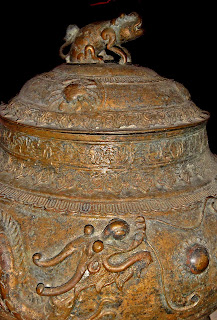This is a gold coin from Sultanah Inayat Shah Zakiat Ad Din Shah era.
She is the third female to be throned in Aceh Sultanate and daughter of
Sultan Muhammad Shah. She reigned Aceh from 1678 - 1688
CE.
In 1683 CE , she had the "honor" of receiving a delegation and gifts
from the Sharif of Mecca which originally intended for Great Moghul
Aurangzeb who refused the delegation.
Aurangzeb coin can be seen in below link :
Aurangzeb Coin
While I couldn't find any reference as why the Mughal Emperor refused
the delegation, I found interesting impact of the delegation visit to
Aceh from the book, Islam in Modern Asia written by I.K. Khan.l
Th original intent of this delegation was to visit Moghul Sultan
Aurangzeb however he refused to entertain them.( If anyone knows the
reason of this refusal please share with us!)
The delegation then stopped in Aceh and was well received by the
Sultanah Zakiat Din and the people of Aceh. Letters and gifts were
presented to the Sultanah. The delegation was asked to stay few days in
Aceh while the Sultanah has ordered the preparation of gifts for them.
One of the gifts prepared was a gold statue made from gold from the
palace and the Bayt Al Rahman Mosque which were destroyed by fire during
the reign of Sultanah Naqittat Din.
These gifts were brought back to Mecca and some of them were distributed to the poor population in the Haramayn.
This visit was a controversial one as the ruler of the Aceh was a woman
whereas the Islamic law prohibit a woman to be a ruler. This visit has
boosted the prestige of the Sultanah. While the Haramayn ulama were
silent in this matter during Sultanah Zakiataddin reign, the people Aceh
have also stop disputing the status of a woman ruler.
The silence was broken during the reign of Sultanah Kamalat Ad Din when
the Chief Mufti of Mecca has issued a fatwa declaring the Islamic
Kingdom cannot be ruled by a woman ruler. As a result, the Sultanah was
deposed from the throne and replace with a male Sultan, Badr Alam.
Looking at the Arabic calligraphy used, its quite tricky as the
calligraphy is compressed to fit on the coin face. However it has the
resemblance to Thuluth & Sini. Or probably this is how Malay
calligraphy was derived.
Obverse : فادك سر سلطانه عناية شاه
Paduka Sri Sultanah Inayah Shah
Reverse : زكية الدين بردولة شاه
Zakiat Ad Din Berdaulat Shah
Aceh is a state located at the northern end of Sumatra island (
Indonesia). It is also known by its Arabic honorific Darus Salam ( Abode of
Peace) from 1511-1959 CE.
Aceh's origins are unquestionably Cham, as the
Champa king Syah Pau Kubah sent his son Syah Pau Ling to rule over Aceh when the
capital Vijaya in 1471 AD, was sacked by the Vietnamese Le Dynasty.
The
Sultanate of Aceh was founded in 1511 CE after the fall of Pasai Sultanate by
Sultan Ali Mughayat Shah. It’s presumed that he is the same person as Syah Pau
Ling who converted to Islam.
The Sultanate lasted till 1903 when the last
Aceh Sultan Muhammad III Daud Shah Johan Berdaulat surrendered to Dutch
occupation.
See my other coin below :
Sultanah Inayat
Sultanah Inayat
Obv: فادك سر سلطانه عناية شاه
Paduka Sri Sultanah Inayah Shah
Rev: زكية الدين بردولة شاه
Zakiat Ad Din Berdaulat Shah
Weight : 0.59 gm
Dim : 14mm
Date : 1678 - 1688 CE
Rarity :
Denom :
Mas
Material : Gold
Reference : A 19a type 4 pg 179 ( Jaarboek Voor Munt-en
Penningkunde)

















































